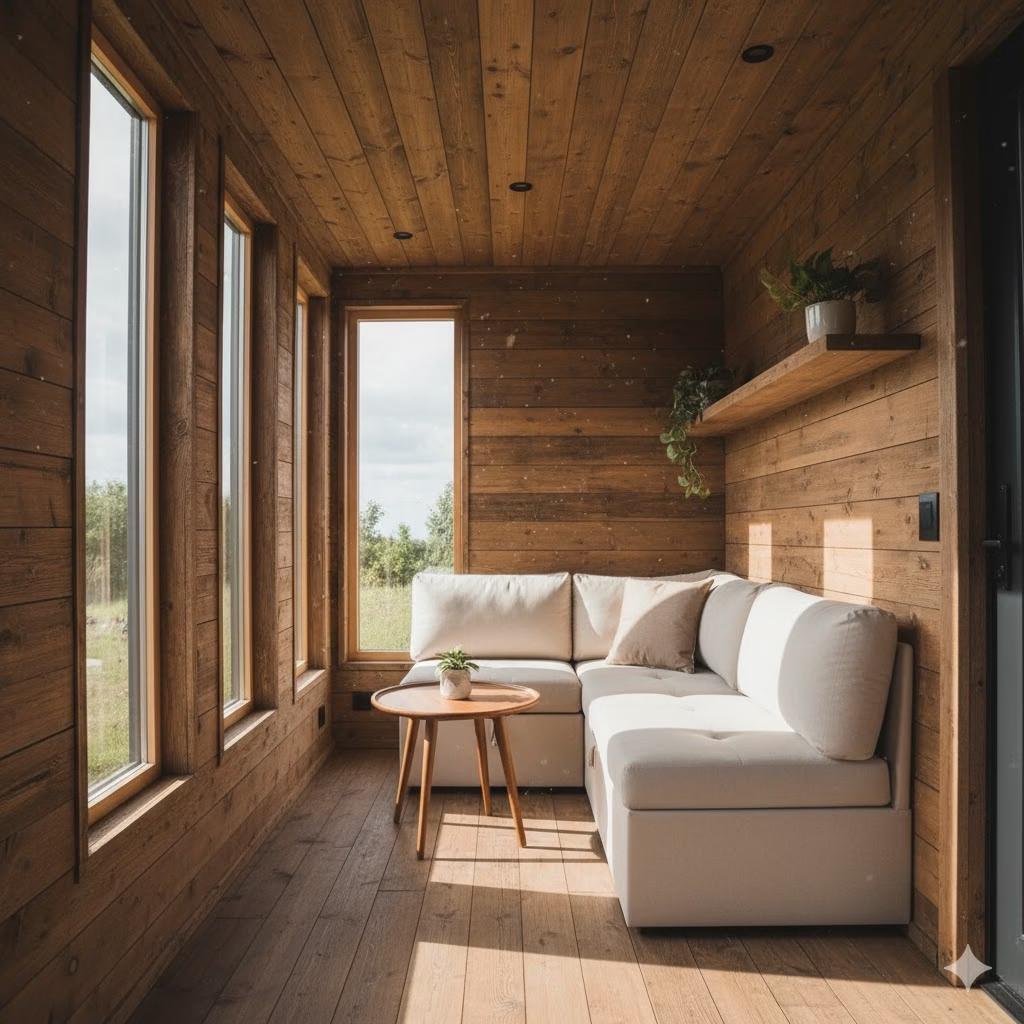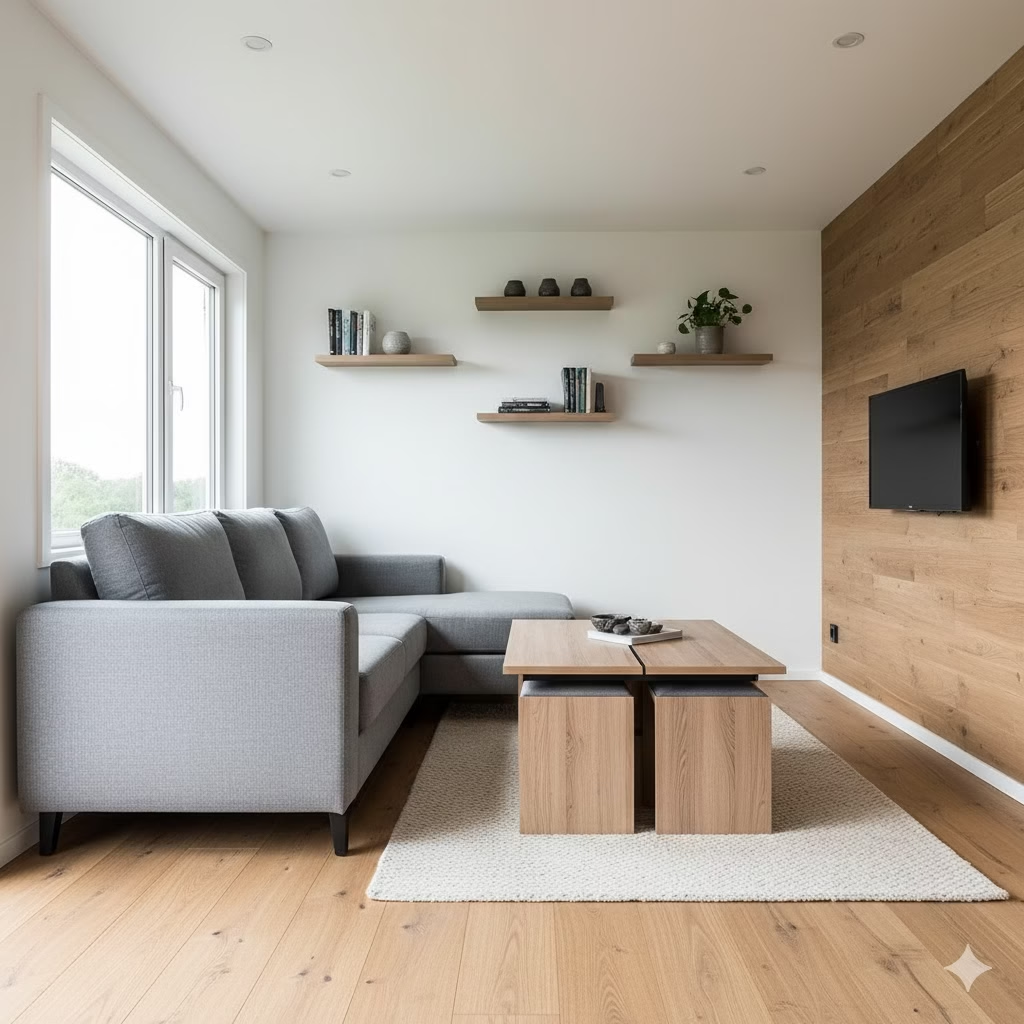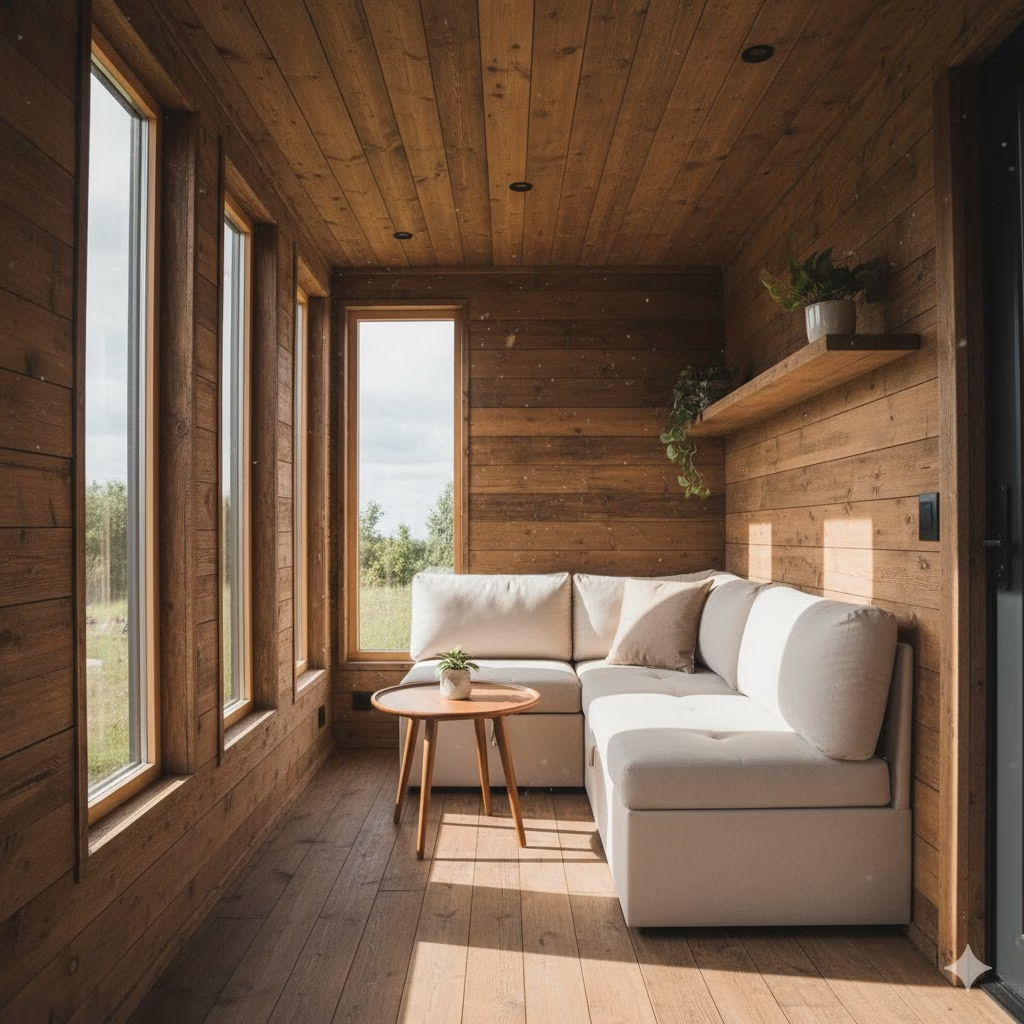
I used to believe that having a big house and lots of things was the key to happiness—but all that stuff felt like a heavy weight. I realized my large, half-used house was taking up too much of my time and money, and its size felt wrong for the planet, especially when it came to sustainability. This journey is about finding true freedom and protecting the Earth. It proves that you don’t need a huge place to be happy; a simple life is often the richest one.
Why Less Space Means More for the Planet
The world is worried about climate change and running out of resources. We desperately need a new way to live. We’ve chased the dream of huge houses and overflowing closets, but it has only brought debt and a giant carbon footprint. The old idea of “more is better” is failing all of us. But there’s a strong, quiet movement with a simple, smart solution: living small.
This is more than just a trend for tiny houses. It’s the New Green Revolution. It’s a clear choice to make our lives better and more eco-friendly by shrinking our living space and owning fewer things. When we redesign where we live, it starts a positive domino effect: it slashes energy use, saves resources, improves our mental health, and boosts our savings. Living small isn’t a sacrifice; it’s the smartest way to ensure a sustainable future.
The Facts: Downsizing is Key to Sustainability
The numbers are clear. A large amount of global pollution comes from the energy we use in our homes, and the main reason is how big they are. The average new house in the U.S. is twice as large as it was in the 1970s, even though families are smaller now. This extra size means a massive jump in the materials needed, the energy used, and the overall damage to the environment.
A key study by Dr. Maria Saxton on the tiny house movement found that people who live in tiny homes (usually between 100 and 400 square feet) have an ecological footprint that is about 45 percent lower than the average American. This huge difference isn’t just about the structure’s size; it comes from the simpler lifestyle that tiny living demands.
1. Less Waste from Building and Materials
Building a large house uses a huge amount of materials—wood, concrete, steel, and insulation. All these materials have a high embodied energy cost, which is the energy spent to dig up, create, ship, and put together the materials.
The Small-Living Advantage:
- Fewer Resources: A small house needs much less raw material. This seriously reduces the environmental damage caused by mining and manufacturing.
- Affordable Eco-Choices: Because the project is small, it’s easier to afford and use premium, sustainable materials. You can choose reclaimed wood, recycled metal, or new, low-carbon options like hempcrete or Structural Insulated Panels (SIPs). Here’s a practical how-to: If you save $1,500 on normal lumber for a large house, you can use that money to buy highly efficient SIPs for a small one. The result is a better, greener home.

2. Saving Massive Amounts of Energy
The biggest costs and environmental problems for any home come from keeping it warm or cool. The rule is simple: less space to heat and cool means you use a lot less energy.
How Small Living Saves Energy: Benefits of Sustainability
- Better Shape for Saving Heat: Small buildings lose less heat because the outside surface area is smaller compared to the inside space. This means less heat escapes in winter and less heat sneaks in during summer.
- Smart Design Power: In a small space, excellent insulation and smart design become vital. Placing windows to catch the sun’s heat, using natural breezes for cooling, and maximizing daylight can drastically reduce the need for active heating, air conditioning, and electric lights.
- Going Solar is Easier: Since the energy needs are low, going off-grid with solar power is much more practical. A small set of solar panels on the roof can often power 100% of a small home’s energy needs. This lets the home reach true net-zero status (using as much energy as it makes) or even be net-positive (making more energy than it uses).
How to Do It:
When you buy appliances, look for the Energy Star label. Also, choose smaller sizes. A compact, energy-efficient fridge or an induction stove can use 30 to 50 percent less energy than standard big models.
The Big Shift: Less Stuff, More Intentional Living
The large sustainability benefits of living small go far beyond the building itself. Downsizing forces us to look hard at our buying habits. When every item must earn its place in a small space, we stop buying things we don’t truly need. This focus on minimalism is the real heart of the New Green Revolution: it’s a direct way to be a great steward of the environment.
3. Less Waste and Longer-Lasting Products
The average person throws away about 4.9 pounds of garbage daily. A large home acts like a “junk drawer” for our endless purchases, hiding the huge amount of things we buy and throw away.
How Small Living Cuts Waste:
- Thoughtful Shopping: With limited storage, you have to be very thoughtful about every purchase. People start buying high-quality, durable items that can be repaired, instead of cheap, disposable goods. This choice directly cuts down on manufacturing waste and reduces landfill trash.
- Repair and Reuse: Small-space living creates a mindset of using everything to its maximum potential. A single item might serve multiple uses. This approach naturally encourages longevity and fixing things instead of throwing them out and replacing them.
Example:
Instead of owning a separate vacuum, floor steamer, and mop, someone in a small home would buy one high-quality, multi-functional cleaning machine. This reduces the energy cost of three products down to one, saves space, and significantly cuts down on electronic waste over time.

Sustainability Living: Life Beyond Your Walls
The mindset of living small often leads to other major sustainable habits.
4. Growing Food in Small Spaces
Not having a lot of land doesn’t mean you can’t grow your own food. You just need to be clever and use vertical space or shared community gardens.
How to Grow Food with Little Space:
- Vertical Gardens: Use wall space on a balcony, patio, or even inside by a sunny window to grow herbs, leafy greens, and strawberries in planters that stack up.
- Container Gardening: Choose small, “patio” types of vegetables like tomatoes, peppers, and beans that grow well in pots.
- Composting is Easy: Even apartment dwellers can compost. Worm farms (vermicomposting) or small, sealed kitchen bins turn food scraps into rich fertilizer for your plants. This greatly reduces the methane pollution that comes from landfills.
(Image Placement 3: A small balcony with vertical planters growing herbs and small vegetables.)

5. Better Transportation and Stronger Communities
Small homes, especially permanent ones, are often built in or near towns where you can walk to things, or close to city centers. This location naturally encourages people to walk, bike, or use public transport. This is a direct attack on the high pollution caused by relying on private cars.
The Power of Sharing:
In tiny house communities or shared housing setups, people often share resources: a community garden, a shared laundry room, a workshop, or central power systems. This shared system is the ultimate in efficiencyand Sustainability. It reduces the need for every household to own its own set of expensive, rarely-used items.

Sustainability: Your Practical Steps
You don’t have to move into a tiny house tomorrow to join this revolution. Living small is a personal journey, and the biggest changes start with your own choices.
Step 1: Declutter for Clarity (The 80/20 Rule)
Most people only use 20% of their belongings 80% of the time. The first step is to be honest about everything you own.
- The ‘One Year Test’: If you haven’t used it in a year, it probably isn’t needed. Recycle, donate, or sell it.
- Be a Curator: Every new item that enters your life should replace an old one, or at least have a specific, useful place.

Step 2: Maximize Space with Smart Design
A smaller footprint demands brilliant planning.
- Look Up High: Install shelves all the way to the ceiling. Use vertical storage racks inside cabinets and drawers.
- Invest in Transformer Furniture: Get furniture that changes shape, like a desk that folds into the wall, a sofa that becomes a dining table, or a bed with built-in storage. These smart products are key to efficient living.
- Use Every Nook: The space under your stairs, the backs of doors, and even small drawers in the base of kitchen cabinets can all be used for storage.

Step 3: Check Your Habits (The Big 3 Impact Areas)
Focus your efforts where they will help the environment the most:
- Energy: Switch to electricity from renewable sources. Use smart power strips to stop electronics from wasting power when on standby. Lower your heating and cooling settings.
- Water: Install low-flow showerheads and faucets. Collect rainwater for watering plants. Take faster showers.
- Food: Eat more meals that focus on plants. Buy food grown locally to cut down on shipping pollution. Compost all food scraps.

Step 4: Focus on Your Home’s Efficiency
Whether you’re building new or improving an old small space, make efficiency your number one goal.
- Insulation is Critical: The best money you can spend is on high-quality, air-tight insulation. Focus on high R-value insulation in the attic and walls.
- Better Windows: Change old windows to high-efficiency double or triple-pane units.
- Go Electric: Switch from gas appliances (like stoves and water heaters) to electric ones, especially heat-pump technology, to work better with a renewable energy grid.
(Image Placement 8: A diagram illustrating high-efficiency insulation and passive solar design.)

Conclusion: A Better Life, A Healthier Planet
The New Green Revolution is all about taking back control from the huge demands of oversized homes and too-busy schedules. Living small is more than a quick trend; it is a clear path toward real Sustainability. It proves that we can live better, not by owning more, but by needing less. This mindful, minimalist approach lowers our demand on the planet, frees up our cash, and helps us focus on experiences, community, and our true purpose. It is the best way to live a life that is truly meaningful and responsible to the world.
Frequently Asked Questions (FAQ)
Q1: Is living small only for single people or young couples?
A: Definitely not! Many families are choosing to live small. The key is in smart design and intentional living. Multi-purpose furniture, clever storage, and shared community spaces allow families to live comfortably in a smaller footprint. It’s about using space fully, not giving up comfort.
Q2: What is the biggest barrier to widespread small living?
A: The main problems are often local zoning laws and building codes. These rules force houses to be a certain minimum size, which basically makes tiny homes illegal or hard to place. To fix this, communities need to speak up and get local rules changed to allow for diverse, sustainable housing options.
Q3: How can I start applying these ideas if I live in a large rental home?
A: The revolution starts with mindful shopping and saving energy.
- Shopping: Use the 80/20 rule to declutter and stop buying things you don’t really need. Use the money you save for experiences or savings.
- Energy: Focus on cheap habits (turn off lights, lower thermostat, etc.) and portable upgrades (LED bulbs, smart power strips).
- Water: Install low-flow showerheads (these are easy to swap out when you move).
(Image Placement 10: Image of a water-saving showerhead or LED light bulb.)
Q4: Will the eco-benefits of a small home disappear if I drive too much?
A: Yes, the pollution from your car can easily undo the good your small home does. Real Sustainability means looking at your whole life. The most effective small homes are near places you can walk to, bike to, or take the bus or train. This helps cut down on or stop the need for a car.
Q5: What are the best eco-friendly building materials for a small home?
A: Choose materials that don’t take much energy to make and will last a long time.
- Reclaimed/Recycled: Old lumber, recycled metal for the roof, and repurposed windows.
- High-Efficiency: Structural Insulated Panels (SIPs) for walls and roofs.
- Natural/Plant-based: Bamboo, cork, sheep’s wool or cellulose insulation (made from recycled paper), and wood from local sources.
References
- Virginia Tech – Chapter 2 Environmental Impacts of Tiny Home Downsizers
- Turmerry – Easy Ways To Live a Sustainable Lifestyle
Recent Posts


